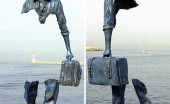Johannah Bernstein post: "eternally proud of my father’s extraordinary aeronautical engineering. legacy. here is a photo of the Canadair Water…
Alberta floods 2013
Written by Diana Thebaud Nicholson // July 26, 2013 // Canada, Natural Disasters // Comments Off on Alberta floods 2013
Naheed Nenshi Dear Diary: ‘This is no miracle, no act of providence. This is Calgary’
Tuesday
Where there was once a flood of ruin there now comes a flood of the righteous: Carpenters, dump-truck drivers and proceeds collected by strangers dwelling in distant time zones. These Samaritans bind our wounds, they bake us bread, they quaff our thirsts with beer, they provide refuge to the weak and they resurrect a city undone. Blessed are the bulldozer drivers, the bringers of water bottles, the makers of doughnuts, the brewers of coffee, the mud-caked clearers of basements and cursed be the food inspectors who stand in their way. (28 June 2013)
Mayor Naheed Nenshi on how to use $52 million tax windfall
(Calgary Herald) … now that the water has receded, we need to think about how to recover, rebuild, and prevent future damage.
A very early estimate is that City public infrastructure lost $250 million in washed-out pathways, damaged public buildings, and broken bridges, among many others. The Zoo alone may have incurred damage of more than $60 million.
We have no choice but to fix this vital infrastructure, and while insurance will cover some of the damage, the rest will have to be borne by all of us as taxpayers.
The provincial and federal governments have made significant commitments to help our city recover, but they won’t end up paying for everything. This isn’t a knock on them; they’ll try hard but there will be expenses that they can’t or won’t cover.
An article in Wednesday’s Herald confirms this: in post-disaster Slave Lake and Medicine Hat, extraordinary expenses ate up huge chunks of those cities’ budgets, and both cities strongly recommend that Calgary set aside some money to cover these.
The province has been pretty clear on this as well. A spokesperson for Alberta Municipal Affairs suggests that money will only be available to restore things to exactly how they were before, not, for example, to harden the assets against future natural disaster by using more durable materials. [emphasis added]
Alberta Floods Have Changed The Rockies Forever, Says Scientist
(Canadian Press) Flooding in southern Alberta has changed the Rockies and their foothills forever and should force the province into providing better protection, says one of Canada’s leading scientists.
John Pomeroy, who holds a Canada research chair in water resources and climate change at the University of Saskatchewan, says the natural disaster has permanently altered everything from how the landscape will handle future flooding to the Bow River’s status as a world-class trout stream.
“The Rockies have changed from this,” said Pomeroy, who spoke from the Alberta mountain community of Canmore, where he works at a field research station. “They’re even going to look a little bit differently.”
The fact rivers flooded near their alpine sources means they were relatively free of the kind of agricultural runoff that could have caused environmental major damage, he said. But those rushing mountain streams that morphed suddenly into torrents have caused their own ecological consequences.
“Even if the climate stayed exactly the same and we just had regular precipitation events in the future, the way the watersheds translate rainfall and snowfall into streamflow is going to be different now.
Already, channels have changed so much that scientists can’t even accurately measure how much water is churning downstream.
Alberta should build flood walls along the Bow River and manage its reservoirs for flood control as well as power generation, Pomeroy suggested. He said it was just luck that some reservoirs upstream from Calgary were unusually low and were able to hold back some of the water.
The province also will have to rethink what it considers developable land, said Pomeroy. The location of some developments in the Bow Valley are actually built on flood plains, something he calls “absurd hubris.” (24 June 2013)
Alberta unveils new flood-proofing rules
Homeowners who stay in high-risk zones would not get future disaster recovery money
(CBC) The province has created new flood-mapping standards in the hopes of preventing future flood events in Alberta.
The new rules categorize areas in high-risk flood zones as being in either the floodway (red zone) or flood fringe (pink area). … Homeowners who live in the floodway can choose to rebuild and repair, or leave. If they stay, they will not be eligible for any future Disaster Recovery Fund assistance. If they choose to relocate, the province will assist them — in some cases, that means by purchasing land.
Homeowners living in flood fringe areas must do flood-proofing if they are to be covered in the future. They will be eligible for an extra 15 per cent on compensation to complete that proofing, which could include efforts like raising homes off the ground.
Homes in floodways will have a notation attached so that future homeowners know the risks of the home they are buying.
Rebuild or relocate? Devastating Alberta floods have some wondering if it’s time to move communities off floodplains
(National Post) as the flood waters leave billions of dollars in damage in their wake, some Albertans are increasingly questioning how — and even whether — to rebuild their homes and businesses. Some of the critics … object to funnelling thousands of taxpayer dollars to replace the homes that line Calgary’s Bow and Elbow Rivers.
… There is no overland flooding insurance in Canada, although some companies have agreed to cover the cost of sewer back up. Still, that will leave thousands of homeowners paying out of their own pocket, or relying on the provinces disaster recovery program.
Government money has been allocated to repair homes that are not covered by insurance. However, the program does not make up for lost property values, it’s only designed to bring damaged residences up to basic functionality.
8 July
Celine Cooper: A mayor who has shown the way
Calgary’s Naheed Nenshi has proved himself a leader people can feel connected to – and there are lessons in that for Montreal
(Montreal Gazette) It is a testament to his leadership and the extraordinary perseverance of Calgarians that two weeks after floods that caused more than 75,000 people to be evacuated from their homes and an estimated $1 billion in damage, the city is getting back on its feet. People are returning home, the Stampede is a go, tourists are being beckoned back.
Back in the saddle: Calgary Stampede ready to throw open its gates
Midway rides are a go, the chuckwagon track and grandstand are restored, and federal politicians wearing large belt buckles have arrived. Calgarians are ready for 10 days of Stampede celebrations.
After a frenetic, around-the-clock effort to clean up the Stampede grounds that were flooded by the swollen Elbow River waters just two weeks ago, many hope the rides, rodeo and entertainment will help cheer Alberta from a series of devastating June floods, and the long cleanup and rebuilding that lies ahead.
1 July

Calgary flooding leads to cancellation of some Stampede events
Clean-up apace to host concerts at Saddledome during 2nd week
(CBC) Crews have pumped millions of litres of water from the rodeo grounds, scraped mud, torn out and replaced drywall and have been sanitizing surfaces in Stampede Park just southeast of downtown as the days tick down to the opening parade later this week.
28 June
Fire chiefs slam cuts to emergency preparedness in wake of Alberta flooding
Aside from the great support offered by Canadian Forces personnel, the federal government has done nothing but get in the way during the Alberta floods, the president of the Alberta Fire Chiefs Association said Friday.
… Chief Brian Cornforth didn’t mince words as he slammed Public Safety Minister Vic Toews and his government’s response to the disaster, as well as its funding cuts to emergency preparedness. “The federal government, they can just stay in Ottawa. They got in the way,” he said, singling out Towes, who visited High River on Wednesday.

Alberta shelved major flood report for six years
(Globe & Mail) 2006 report called on the province to, among other things, stop selling flood-plain land for development. But the report sat idle and was released only last year with nothing more than “minimal” flood-mitigation efforts from the province, he said.
Alberta could have reduced flood damage, critics say
Government failed to act on report shelved after disastrous 2005 flood
(CBC) Successive Alberta Conservative governments failed to act on a shelved 2006 flood-mitigation report that critics now say may have significantly reduced flooding, the displacement of thousands of people, and potentially hundreds of millions of dollars in damages.
“[The report] was very prescient,” said Paul Kovacs, executive director of the Institute for Catastrophic Loss Reduction, a think tank at Western University in Ontario.
“In 2005, [Alberta] had a terrible rain event, and the first line of the report said there was the risk that we could have an extreme rain event again,” Kovacs said. “People could die, properties could be damaged. And that is exactly what we are going through right now.”
The government commissioned the Provincial Flood Mitigation Report following floods in southern Alberta in 2005 that were then considered the worst natural disaster in the province’s history.
Completed in November 2006, the report made 18 recommendations. But, inexplicably, the report was shelved for nearly six years and was only publicly released on a Friday before a long weekend in late July 2012.
24 June
Calgary’s Manhattan Moment
I only hope my city’s nightmare is the climate change wake-up Alberta, and Canada, needs.
By Andrew Nikiforuk
(The Tyee) We thought we were big and powerful and beyond humbling just like New York. But as every true cowboy knows, Mother Nature invariably has the last word.
And so Calgarians are now living a chronicle foretold by climate scientists.
Many once worked at federal agencies that the nation’s federal government ruthlessly axed in an ideological assault on science and reason.
Alberta flood recovery could take 10 years, says premier
Most Calgary homes cleared for families to return
“I promise you that, on behalf of the government of Alberta, we will do everything that it takes for people to rebuild their homes and rebuild their lives and rebuild their communities,” the premier said.
Redford, who addressed media Monday, said the flooding would have a huge effect on the provincial budget.
The premier announced that the province had approved a $1-billion preliminary emergency fund to deal with the funding. Part of that will be for “cash cards” for residents who have not been able to return home yet. That funding will start to be handed out in the next week or two, she said.
23 June
 Calgary Flooding 2013: Naheed Nenshi Gives Redundant Message To Calgarians (VIDEO)
Calgary Flooding 2013: Naheed Nenshi Gives Redundant Message To Calgarians (VIDEO)
When Calgary Mayor Naheed Nenshi addressed the city on Sunday, he couldn’t believe he had to state the obvious, which apparently wasn’t obvious enough.
“I can’t believe I actually have to say this,” said Nenshi, “but I’m going to say it. The river is closed.”
“You cannot boat on the river. I have a large number of nouns that I can use to describe the people I saw in a canoe on the Bow river today. I am not allowed to use any of them. I can tell you, however, that I have been told that despite the state of local emergency, I’m not allowed to invoke the Darwin law.”
10 Reasons Why Calgarians Love Nenshi (or, How to Be a Leader)
I’ve heard it said that a person’s true personality comes out in a crisis. If that’s true, then thousands of people may well have fallen (further) in love with Calgary’s own Mayor Nenshi these past few days.
When Nenshi ran for mayor three years ago, he wasn’t a serious contender according to the pollsters. Still, my husband and I put a sign on our lawn, believing that this Harvard-educated, articulate, and worldly young Calgarian was the future we wanted for our city.
He won the election.
Convincingly.
But in the crushing crisis of this Flood of the Century, I realize that it’s Calgarians who’ve won.
22 June
Why Alberta’s floods hit so hard and fast
Record rainfall, saturated ground and unforgiving landscape lead to devastation
Southern Alberta is no stranger to flooding, but this week’s devastation from Canmore to Calgary and beyond was the result of a unique confluence of unexpected weather and a still partially frozen landscape unable to soak up the unprecedented deluge.
Hydrologists who watch the waterways like the Bow and Elbow rivers say several factors were at play since the rain started to fall about four days ago.

21 June
At least 100,000 Albertans displaced, large areas of Calgary’s downtown evacuated
Floodwaters have caused massive disruptions in Calgary, as well as several other southern Alberta communities, including Canmore and High River.
As Albertans faced more rain Friday, the downpour has left hundreds of homes semi-submerged, lifted railroad tracks and inundated the Calgary Stampede grounds.
At least 100,000 Albertans, including about 75,000 Calgarians, have been forced out of their homes and large areas of Calgary’s downtown core were being evacuated Friday afternoon.
Photo gallery: Calgary streets before and during the flood




